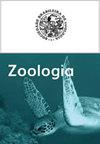巴西帕拉那凤梨科蚜蝇幼虫幼体发育、生物学及dna条形码分析
IF 1.8
4区 生物学
Q4 ZOOLOGY
引用次数: 0
摘要
Quichuana Knab, 1913是新热带花蝇属(双翅目:蚜蝇科),现有50种。成虫是访花昆虫,其幼虫通常与凤梨科和向日葵的植物端部为伴,积极参与森林环境中养分的循环利用。尽管它们在生态系统动力学中很重要,但人们对其知之甚少。在此,我们描述了Quichuana pogonosa Fluke, 1937的未成熟阶段,来自巴西帕拉纳本文章由计算机程序翻译,如有差异,请以英文原文为准。
Description of the immature stages, biology and DNA-barcoding of Quichuana pogonosa (Diptera: Syrphidae) collected in Bromeliaceae in Paraná, Brazil
Quichuana Knab, 1913 is a Neotropical genus of flower flies (Diptera: Syrphidae) with 50 valid species. Adults of this genus are flower visitors and their larvae are usually associated with the phytotelmata of bromeliads and heliconias, actively participating in the recycling of nutrients in forest environments. Despite their importance in ecosystem dynamics, Quichuana larvae are poorly known. Herein we describe the immature stages of Quichuana pogonosa Fluke, 1937 from samples collected from the phytotelmata of two terrestrial bromeliad species in the state of Paraná, Brazil. We provide illustrations of the egg, third instar larva and puparium, as well as information on the life cycle of the species. Additionally, we describe and illustrate the male genitalia and present the DNA-barcoding based on larva and adult specimens.
求助全文
通过发布文献求助,成功后即可免费获取论文全文。
去求助
来源期刊

Zoologia
生物-动物学
自引率
0.00%
发文量
15
期刊介绍:
Zoologia, the scientific journal of the Sociedade Brasileira de Zoologia (SBZ), is an international peer-reviewed, open-access Zoological journal that publishes original research on systematics, evolution, taxonomy, nomenclature, biogeography, morphology, physiology, biology, ecology, symbiosis, conservation, behavior, genetics and allied fields. The journal, formerly known as Revista Brasileira de Zoologia, publishes original articles authored by both members and non-members of the Society. The manuscripts should be written exclusively in English.
 求助内容:
求助内容: 应助结果提醒方式:
应助结果提醒方式:


